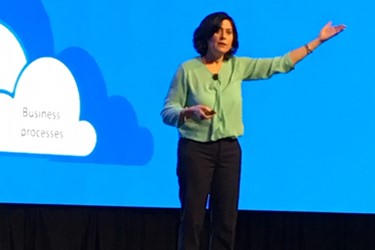Conversations On The Cloud: A Report From Ingram Cloud Summit X

By Matt Pillar, chief editor

Gavriella Schuster, VP commercial partnership at Microsoft helped kick off Ingram’s Cloud Summit X in San Diego this week in front of more than 1,500 attendees with an abbreviated history of the IT channel and the rapid change it’s seeing of late. She focused those comments in the context of the cloud’s impact on a channel that’s looked pretty static for the past 40 years.
“The IT channel was a linear and largely one-way business model, from software to distribution to resellers to end users,” she said. “Cloud services changes all those roles. The customer expectations are changed. Tech is no longer powering the back office through the back door. Now it is the product.” The new cloud-driven channel Schuster describes now looks more like software provider-to-distributor, which in Ingram’s case acts as the service provider of IP, support, and services-to the VAR or MSP-to the end user, and back again, repeatedly and incessantly. “It’s a constant flow of data and services – including collaboration tools, file sharing, data contingency, back up, security, and more – throttled up and down all day, every day,” explains Schuster.
That newfound and constant cloud-driven exposure to applications fuels a question Schuster increasingly fields. Will cloud services push Microsoft to sell direct? She offers up an emphatic “no.” “Cloud services demands that everyone in the IT channel step up their value proposition and play their role in the always-on nature of value delivery,” she says. “Microsoft needs partners now more than ever,” she says, to serve as conduits of that data and those services to the client based on the client’s ever-changing wants and needs.
But the accessibility of apps via the cloud is driving bigger change via its fragmentation at the partner level. VARs and MSPs are joined by a rapidly growing and ill-defined legion of technology providers. I asked Ingram execs about that, and to share the characteristics that define its partner pool today and what those characteristics might be moving forward.
Renee Bergeron, SVP, Global Cloud at Ingram Micro, acknowledged that convergence is prolific in the industry right now. Ingram Micro itself is experiencing it, she said. “We’re no longer just a distributor, but an ISV. And the prevalence of the ISV play is a big deal to Ingram, because ISVs are playing a bigger role in the channel ecosystem,” she said. “In the past it was big vendors serving VARs and MSPs. Now we see a proliferation of ISVs that are accessible and becoming integral parts of channel solutions, and more of our traditional channel partners are developing software and becoming ISVs.”
How is Ingram facilitating the onboarding of a diverse new mix of channel partners? The platform that CTO and SVP David Wippich and his team have created is purpose-built in a modular way to serve the buy-side and the supply-side, because, as Wippich told me, partners are increasingly playing both roles. “We want to sell to all of them, so we approach the market with multiple points of entry on the platform,” he said.
Tim FitzGerald, VP, Cloud Channel Sales North America at Ingram, simplified the hierarchy of the company’s cloud go-to-market strategy. “We [the channel] serve end clients who are looking to solve business challenges,” he said. “We’re partnering with the IP holders who address those challenges, and part of the reason we’re seeing different types of partners emerge is simply because they’re needed. We [Ingram Micro] have to join them together and solve for what’s provided at one end and what’s needed at the other. Clearly that’s a role beyond that of distributor, and it’s a role we’re happy to play.”
To play that role, the company set some lofty goals and put some mighty resources behind them. Bergeron harkened back to Ingram’s early strategic decision to put a full head of steam behind it’s cloud marketplace. “We separated the cloud business from the rest of the business on purpose, so we could move fast. It’s about getting there quickly. We’ll worry about efficiency and reintegration later. Our Cloud initiative was like a startup within a $50 billion company,” she said.
But, just how far ahead of the cloud curve is Ingram? Are its partners, and the channel in general, ready for full-on cloud? Bergeron says Ingram’s cloud platform allows it to onboard ISVs and partners at a rapid pace, and it has, but she also acknowledges that it’s challenging for solutions providers to keep up. “We’re seeing struggles with demand generation, business model transitions to subscription-based services, sales, and marketing plans, and we’ve developed a hub of solutions to help our partners solve for those challenges,” she says. “Successful partners are those who leave the back office behind, focus on customer service during the delivery cycle, and leave the plumbing to Ingram and their cloud-savvy vendor partners.”
The traction is measurable. The company’s Cloud Marketplace boasts 55,0000 partners since its inception a decade ago, an increase of 10,000 in 2018 alone. Those partners facilitate applications to more than four million fully-automated seats. CloudBlue, Ingram’s independent ISO division, represents 27 million enterprise cloud subscriptions tallying more than $1 billion in annual subscription revenue.
